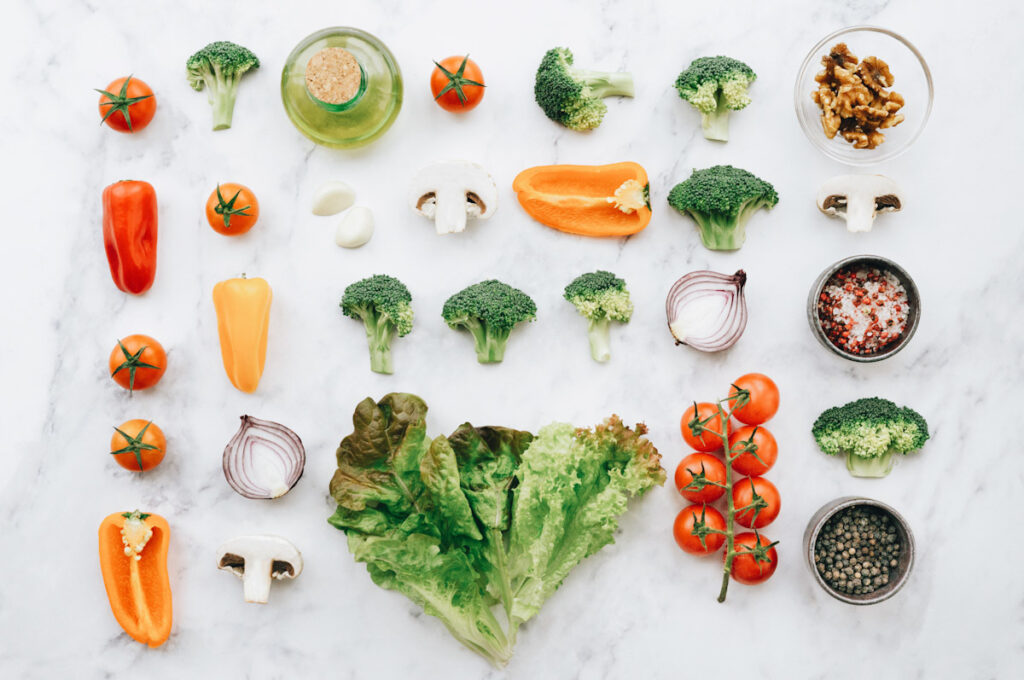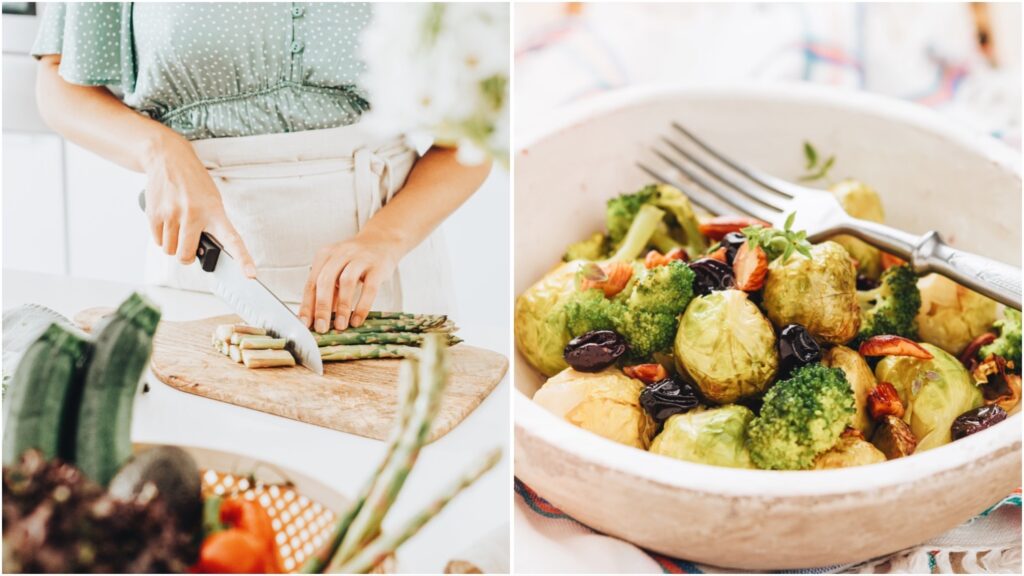There aren’t many aspects of Neanderthal living that are palatable to our modern conveniences. (Rubbing two sticks together to start a fire? No, thanks.) However, there is one notable exception: the paleo diet, a popular diet composed of foods eaten by our prehistoric ancestors. But with its meat-heavy reputation, is it possible to follow a paleo vegan diet?
“Paleo” refers to the Paleolithic era, which occurred 2.5 million to 10,000 years ago. During that era, people primarily ate food that could be hunted, gathered, or foraged. As a result, the paleo diet is sometimes called the cavemen diet or the Stone Age diet. Whatever you call it, the diet “centers on the idea that eating like our original ancestors is aligned with our genetics and therefore optimal for good health,” UC Davis Health explains.
If you are seeking to eat a plant-based paleo diet, there are a number of benefits that you’ll find. The paleo vegan diet is low in sugar, sodium, and simple carbohydrates, and the elimination of dairy means it is low in saturated fats. A plant-based Paleo diet even has a name: the pegan diet!
First, let’s cover the basics of the paleo diet. According to the tenets of the diet, you can eat lean meat, including wild game or grass-fed animals; fish and seafood; vegetables; fruits; nuts; and seeds.
Dairy is excluded from the paleo diet. So are grains like wheat or barley; legumes, like edamame, chickpeas, peanuts, beans, and lentils; or processed potatoes, such as mashed potatoes or fries. That’s because these foods arrived during or after the agricultural revolution, or Neolithic period, approximately 12,000 years ago, according to National Geographic. At this time in history, many humans transitioned away from hunting, gathering, and foraging and toward farming.
Processed foods, like hot dogs or soda, are also excluded. Additionally, quinoa is not part of a paleo diet. And soy-based foods like tofu and tempeh are also excluded from the paleo diet, because soybeans are legumes, and legume cultivation began in the Neolithic period.
There is a misconception that the paleo diet means eating mostly meat, especially red meat. Alas, that myth is based on popular images of Neanderthals, not historical records. According to Alex Nella, a dietician at UC Davis, prehistoric people ate whatever food was most abundant near them, which means the diet varies. Some people would eat primarily fish and seafood if they lived near water, while others who lived in the forest primarily consumed plants, nuts, and seeds. In the Paleolithic era, people would eat wild game and grass-fed animals, but certainly did not eat only meat.

What do paleo vegans eat?
The paleo vegan diet eliminates all animal-derived foods. This leaves the following foods to eat:
- Vegetables
- Fruits
- Nuts
- Seeds
- Oils (olive, coconut, avocado, and almond)
According to Dr. Mark Hyman, who is credited with coining the term “pegan,” you should eat 75 percent plants and the remainder of your food intake should be nuts and seeds.
As for beverages on the paleo vegan diet, look to water, tea and fermented drinks like kombucha. (Coffee, soft drinks, and fruit juices are not paleo.) Paleo vegans can also drink nut-based milks, such as almond milk or macadamia milk.

Benefits of the paleo vegan diet
The foods you’ll eat on the paleo vegan diet all have numerous health benefits.
Fruits and vegetables are rich in nutrients, including vitamin C, vitamin A, folic acid, dietary fiber, and potassium. If you eat a “rainbow” of fruits and vegetables as dieticians recommend, you are getting a good variety of nutritional benefits. Fruits and vegetables are also both low in fat and calories and contain no cholesterol.
Seeds and nuts are both rich in protein and fiber. Seeds are also good sources of iron, calcium, magnesium, and phosphorus, according to the Cleveland Clinic.
And about those nuts: though as much as 80 percent of a nut is fat, the Mayo Clinic reassures us that nuts contain “good” fats, or mono- and polyunsaturated fats and omega-3 fatty acids. While you should still eat nuts in moderation, these little calorie bombs aren’t as potentially unhealthy as they sound. Nutrition experts think the “good” fats in nuts outweigh the “bad” fats and contribute to lower “bad” cholesterol. Nuts are also filling, given their small size.
Other health benefits of the paleo vegan diet
It’s dairy-free
Dairy isn’t part of a vegan diet, so if you are eating a paleo vegan diet, you won’t be eating milk, butter, eggs, cheese, or yogurt either. Giving up dairy can also be beneficial to your health, provided you source your protein and vitamin D elsewhere. Dairy products, including butter and whole milk, are a source of saturated fats, which can raise your “bad” cholesterol. Too much “bad” cholesterol can put you at risk for developing heart disease. Additionally, a lot of people have dairy sensitivities, including lactose intolerance, which can lead to gas, bloating, stomach aches, cramps, and diarrhea.
It’s low in sugar
Added sugars, typically found in processed foods, can cause chronic diseases like type 2 diabetes and may increase your risk of heart disease.
It’s low-sodium
High-sodium diet are associated with an increased risk of developing high blood pressure, which can lead to heart disease and stroke.
It’s low in simple carbohydrates
Carbohydrates provide fuel for our bodies. There are two types of carbs that provide different types of fuels. Complex carbohydrates, which are found in whole grains, vegetables, legumes, and nuts, provide energy over the longer term. Meanwhile, simple carbohydrates (sometimes called “bad carbs”) quickly break down into sugar in your system. The paleo vegan diet is low in simple carbohydrates, so you’re mostly consuming the “good” fuel.

Are there disadvantages to a paleo vegan diet?
The paleo vegan diet is not for everyone. There are some disadvantages to consider before making the transition.
You need to find other sources of omega-3 fatty acids
Your body needs omega-3 fatty acids. These are called alpha-linolenic acid (ALA), eicosapentaenoic acid (EPA) and docosahexaenoic acid (DHA). On the paleo diet, eating fish would provide you these omega-3 fatty acids. Fortunately, other good sources of omega-3s that are paleo vegan-friendly include flaxseed oil, chia seeds, and walnuts.
You won’t have legumes as a protein source
On the paleo vegan diet, you won’t be eating legumes and whole grains. Therefore, you’ll need to replace the fiber and other nutrients that you would have gotten from both those foods. Whole grains, like brown rice and barley, are sources of fiber and B vitamins. You’ll want to source these nutrients from seeds, nuts, fruits, and vegetables. If you are eating a paleo vegan diet, you will need to source your protein from other foods. (More on that below.)
It might be expensive
There’s an economic aspect of the paleo vegan diet to consider. Legumes are typically one of the least expensive foods that anyone can eat. If you are eliminating legumes on the paleo vegan diet, you’ll want to factor into your budget that your new sources of protein may be more costly.
How to get enough protein on the paleo vegan diet
Protein is a crucial component of our nutritional wellbeing; it is an energy source and it builds muscle and bones.
Plant-based sources of protein include legumes like beans and lentils. However, the Paleo vegan diet eliminates legumes as an option. So how do you get enough protein as a paleo-vegan?

Plant-based options high that are high in protein
- Asparagus (4.32 grams of protein per cup)
- Almonds (6 grams of protein per ounce)
- Avocado (4 grams per avocado)
- Broccoli (4.28 grams per stalk)
- Brussels sprouts (5.6 grams of protein per cup)
- Chia seeds (4.69 grams of protein per ounce)
- Coconut (3 grams of protein per one cup of raw meat)
- Hemp seeds (5 grams of protein per tablespoon)
- Kale (2 grams of protein per cup)
- Mushrooms (3 grams of protein per 5 medium mushrooms)
- Pistachios (6 grams of protein per ounce)
- Potatoes (7 grams of protein per one large unprocessed potato)
- Yellow sweet corn (4.689 grams of protein per ear, raw)
One more option for making sure you get enough protein is a paleo vegan protein powder. A product like Peak Performance Grain Free Complete Plant Protein can be added to smoothies or dairy-free milks as a way to get your protein in.
That being said, the American Dietetic Association recommends eating whole foods for nutrients, instead of supplements.
How to start the paleo vegan diet
Before beginning any diet, consult a nutritionist who can help you actualize your health goals. If you’re looking to begin eating a Paleo vegan diet, learn the foods you’ll need to eat in order to intake the recommended amount of vitamins and minerals.


